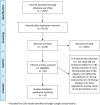A Systematic Review of Key Factors in the Effectiveness of Multisector Alliances in the Public Health Domain
- PMID: 32489103
- PMCID: PMC7747138
- DOI: 10.1177/0890117120928789
A Systematic Review of Key Factors in the Effectiveness of Multisector Alliances in the Public Health Domain
Abstract
Objective: The purpose of this systematic literature review is to assess the factors associated with synergistic multisector alliances in the public health domain.
Data source: Articles in PubMed, CINAHL, Scopus, and Google Scholar between March 2009 and February 2019 were searched.
Study inclusion and exclusion criteria: Included alliances had a public health and behavioral focus, were from the public or private sector, and were multipartner and multisector, and from high-income countries. Public health research alliances were included, but clinical research alliances were excluded.
Data extraction: Data extraction included alliance description, alliance domain, country, single or multiple alliances, and the sectors included in the alliance. Two theoretical frameworks were used in data extraction.
Data synthesis: Data were coded according to 28 factors representing antecedents, management, and evaluation (Parent and Harvey model) and 3 output-specific factors (Bergen model).
Results: A final 24 papers were included, of which 58% contained synergistic alliances. While almost all factors reportedly enabled synergy, some factors were more frequently associated with synergistic alliances, including clear purpose and positive coordination, information sharing, and evaluation of project outcomes. Complexity within some factors was also reported.
Conclusion: The theoretical models were supported by the data. Public health alliances would likely benefit from incorporating factors identified as beneficial for synergy and from carefully considering the management of complex factors.
Keywords: alliance; collaboration; evaluation; health promotion; multisector partnerships; public health and literature review; synergy.
Conflict of interest statement
Figures
Similar articles
-
The Healthy ALLiances (HALL) framework: prerequisites for success.Fam Pract. 2012 Apr;29 Suppl 1:i132-i138. doi: 10.1093/fampra/cmr088. Fam Pract. 2012. PMID: 22399543
-
The private partners of public health: public-private alliances for public good.Prev Chronic Dis. 2009 Apr;6(2):A69. Epub 2009 Mar 16. Prev Chronic Dis. 2009. PMID: 19289012 Free PMC article.
-
Cross-Sector Strategic Alliances Between Health Care Organizations and Community-Based Organizations: Marrying Theory and Practice.Adv Health Care Manag. 2022 Dec 12;21. doi: 10.1108/S1474-823120220000021005. Adv Health Care Manag. 2022. PMID: 36437618
-
Meanings and mechanisms of One Health partnerships: insights from a critical review of literature on cross-government collaborations.Health Policy Plan. 2022 Mar 4;37(3):385-399. doi: 10.1093/heapol/czab134. Health Policy Plan. 2022. PMID: 34791224 Free PMC article. Review.
-
Systematic review of the Exploration, Preparation, Implementation, Sustainment (EPIS) framework.Implement Sci. 2019 Jan 5;14(1):1. doi: 10.1186/s13012-018-0842-6. Implement Sci. 2019. PMID: 30611302 Free PMC article.
Cited by
-
Effectiveness of Network Relations in Poland during the Economic Crisis Caused by COVID-19: Interorganizational Network Viewpoints.Int J Environ Res Public Health. 2023 Jan 9;20(2):1178. doi: 10.3390/ijerph20021178. Int J Environ Res Public Health. 2023. PMID: 36673933 Free PMC article.
-
A conceptual framework for analysing partnership and synergy in a global health alliance: case of the UK Public Health Rapid Support Team.Health Policy Plan. 2022 Mar 4;37(3):322-336. doi: 10.1093/heapol/czab150. Health Policy Plan. 2022. PMID: 34919688 Free PMC article. Review.
-
Drowning prevention: turning the tide on a leading killer.Lancet Public Health. 2021 Sep;6(9):e692-e695. doi: 10.1016/S2468-2667(21)00165-1. Epub 2021 Jul 24. Lancet Public Health. 2021. PMID: 34310906 Free PMC article. Review.
-
Enhancing multi-sectoral collaborations for the prevention and control of NCDs in Thailand with a new approach.Health Res Policy Syst. 2024 Dec 18;22(1):169. doi: 10.1186/s12961-024-01262-z. Health Res Policy Syst. 2024. PMID: 39696316 Free PMC article.
-
Community networks of sport and physical activity promotion: an analysis of structural properties and conditions of cooperation.BMC Public Health. 2022 Oct 26;22(1):1966. doi: 10.1186/s12889-022-14383-3. BMC Public Health. 2022. PMID: 36289498 Free PMC article.
References
-
- Parent MM, Harvey J. Towards a management model for sport and physical activity community-based partnerships. Eur Sport Manage Quart. 2009;9(1):23–45.
-
- Vegetable Intake Strategic Alliance. 2019. https://www.vegkit.com.au/vegkit-project/vegetable-intake-strategic-alli.... Accessed December 5, 2019.
-
- Corbin JH, Mittelmark MB. Partnership lessons from the global programme for health promotion effectiveness: a case study. Health Promot Int. 2008;23(4):365–371. - PubMed
-
- Gillies P. Effectiveness of alliances and partnerships for health promotion. Health Promot Int. 1998;13(2):99–120.
Publication types
MeSH terms
LinkOut - more resources
Full Text Sources



